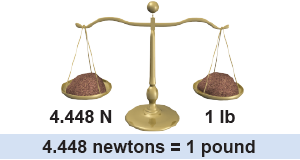|
Physics is based on the idea of cause and effect, which means that any change that we observe must have a cause. For example, the downward acceleration of a falling ball is caused by the force of Earth’s gravity. The previous chapter described acceleration; in this chapter we will see that acceleration is caused by forces. You may not realize it, but you already know about one kind of force: weight, or the force due to Earth’s gravity. In this section you will learn about forces and how to represent them visually on a free-body diagram. 
|
Forces
|
 We all have an intuitive sense of the meaning of force. Force is an action represented by words such as push or pull. You probably exerted both pushing and pulling forces today without thinking about it. In physics, the concept of force is defined with strength (or magnitude), direction, and units.
We all have an intuitive sense of the meaning of force. Force is an action represented by words such as push or pull. You probably exerted both pushing and pulling forces today without thinking about it. In physics, the concept of force is defined with strength (or magnitude), direction, and units. 
|

|
The SI unit of force is the newton. One newton (N) is about the weight of a cellphone—a rather small force. You can easily exert a force of 100 N or more with one arm. Technically, one newton is the force required to change an object’s velocity by one meter per second in one second. This is where the newton gets its fundamental units: One newton is the force required to accelerate one kilogram at one meter per second per second (1 N = 1 kg m/s2). 
|
Forces are connected to acceleration—to changes in motion. An object at rest will stay at rest unless there is a force applied that causes the object to accelerate. Less obvious is that an object already moving will keep moving until a force is applied to change its velocity. Picture an ice skater on ideal frictionless ice. The skater could coast forever if there were neither friction nor other forces applied to slow her down or turn her. In other words, if no force is acting on her then her velocity will remain constant; i.e., her acceleration is zero. 
|

| In your everyday life, force is often measured in pounds. One pound (lb) is equal to 4.448 N. If you weigh 100 lb you also weigh 444.8 N. In the grocery store, pounds are divided into ounces. One pound equals 16 ounces, so one newton is a just a bit less than 4 ounces. Many practical problems in life, such as buying a rope or building a house, will require you to understand forces in pounds. For most physics problems, however, the relationship between force and motion makes it much more convenient to use newtons. |

|
An object at rest will not change its velocity unless there is a _________ applied that causes the object to accelerate. - speed
- force
- distance
- time
 |
The answer is b, force. 
|
| |
|

